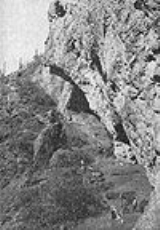
Ventana Cave
Encyclopedia
Ventana Cave is an archaeological site in southern Arizona
. It is located on the Tohono O'odham Indian Reservation. The cave was excavated by Emil Haury
and Julian Hayden in 1941-42. The deepest artifacts from Ventana Cave were recovered from a layer of volcanic debris that also contained Pleistocene
horse, Burden's pronghorn
, tapir
, sloth
, and other extinct and modern species. A projectile point from the volcanic debris layer was compared to the Folsom Tradition
and later to the Clovis culture
, but the assemblage was peculiar enough to warrant a separate name – the Ventana Complex. Radiocarbon dates from the volcanic debris layer indicated an age of about 11,300 BP.
Bruce Huckell and C. Vance Haynes restudied the Ventana Cave stratigraphy and artifact assemblage in 1992-1994. New radiocarbon dates and reanalysis of the artifacts indicates that the volcanic debris layer was laid down between 10,500-8,800 BP. Huckel & Haynes hypothesized that vertical turbation (postdepositional disturbance) is responsible for Haury's original interpretation that these extinct fauna were killed with stone tools. "This turbation may have led to the incorporation of bones of extinct fauna from an underlying conglomerate deposit rich in horse remains, creating the impression of their association with artifacts". Huckel & Haynes believe the Ventana Complex is post-Clovis, and not closely related.
Ventana Cave was declared a National Historic Landmark
in 1964.
Arizona
Arizona ; is a state located in the southwestern region of the United States. It is also part of the western United States and the mountain west. The capital and largest city is Phoenix...
. It is located on the Tohono O'odham Indian Reservation. The cave was excavated by Emil Haury
Emil Haury
Emil Walter "Doc" Haury was an influential archaeologist who specialized in the archaeology of the American Southwest....
and Julian Hayden in 1941-42. The deepest artifacts from Ventana Cave were recovered from a layer of volcanic debris that also contained Pleistocene
Pleistocene
The Pleistocene is the epoch from 2,588,000 to 11,700 years BP that spans the world's recent period of repeated glaciations. The name pleistocene is derived from the Greek and ....
horse, Burden's pronghorn
Pronghorn
The pronghorn is a species of artiodactyl mammal endemic to interior western and central North America. Though not an antelope, it is often known colloquially in North America as the prong buck, pronghorn antelope, or simply antelope, as it closely resembles the true antelopes of the Old World and...
, tapir
Tapir
A Tapir is a large browsing mammal, similar in shape to a pig, with a short, prehensile snout. Tapirs inhabit jungle and forest regions of South America, Central America, and Southeast Asia. There are four species of Tapirs: the Brazilian Tapir, the Malayan Tapir, Baird's Tapir and the Mountain...
, sloth
Sloth
Sloths are the six species of medium-sized mammals belonging to the families Megalonychidae and Bradypodidae , part of the order Pilosa and therefore related to armadillos and anteaters, which sport a similar set of specialized claws.They are arboreal residents of the jungles of Central and South...
, and other extinct and modern species. A projectile point from the volcanic debris layer was compared to the Folsom Tradition
Folsom tradition
The Folsom Complex is a name given by archaeologists to a specific Paleo-Indian archaeological culture that occupied much of central North America...
and later to the Clovis culture
Clovis culture
The Clovis culture is a prehistoric Paleo-Indian culture that first appears 11,500 RCYBP , at the end of the last glacial period, characterized by the manufacture of "Clovis points" and distinctive bone and ivory tools...
, but the assemblage was peculiar enough to warrant a separate name – the Ventana Complex. Radiocarbon dates from the volcanic debris layer indicated an age of about 11,300 BP.
Bruce Huckell and C. Vance Haynes restudied the Ventana Cave stratigraphy and artifact assemblage in 1992-1994. New radiocarbon dates and reanalysis of the artifacts indicates that the volcanic debris layer was laid down between 10,500-8,800 BP. Huckel & Haynes hypothesized that vertical turbation (postdepositional disturbance) is responsible for Haury's original interpretation that these extinct fauna were killed with stone tools. "This turbation may have led to the incorporation of bones of extinct fauna from an underlying conglomerate deposit rich in horse remains, creating the impression of their association with artifacts". Huckel & Haynes believe the Ventana Complex is post-Clovis, and not closely related.
Ventana Cave was declared a National Historic Landmark
National Historic Landmark
A National Historic Landmark is a building, site, structure, object, or district, that is officially recognized by the United States government for its historical significance...
in 1964.
Further reading
- E. W. Haury, 1950, The stratigraphy and archaeology of Ventana Cave. Tucson: University of Arizona Press
External links
- http://books.google.com/books?id=_0u2y_SVnmoC&pg=RA1-PA864&lpg=RA1-PA864&dq=ventana+cave+arizona&source=bl&ots=OQr2VEZT2G&sig=QMvNZoWi94WuzmMfUugNwufLPFE&hl=en&ei=-h8BSrPFCoWitgO42sX-BQ&sa=X&oi=book_result&ct=result&resnum=6 Guy E. Gibbon, Kenneth M. Ames, 1998, Archaeology of prehistoric native America: an encyclopedia. Taylor & Francis, 1998. ISBN 081530725X

